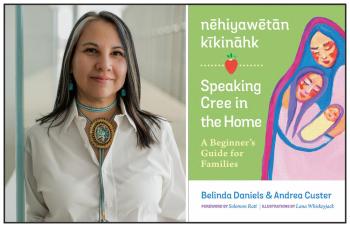Image Caption
Summary
Local Journalism Initiative Reporter
Windspeaker.com
Belinda Daniels and Andrea Custer may have taken different routes to Cree language fluency, but the two educators and mothers share a single philosophy: It is important for their children to feel comfortable with nēhiyawēwin and that starts at home.
“Language helps strengthen our mental well-being, our wellness, is significant to our sense of identity and, if we speak our language, we’re more whole,” Daniels told Windspeaker.com on the launch of nēhiyawētān kīkināhk/Speaking Cree in the Home, the book she co-authored with Custer.
nēhiyawētān kīkināhk serves as a hands-on practical guide for making Cree the language spoken in the household.
What makes the book unique, says Daniels, is the approach. Although both women are nēhiyaw, Custer is a Cree language primary speaker and Daniels is a Cree language secondary speaker.
Daniels, a member of the Sturgeon Lake First Nation in Saskatchewan, was raised by her maternal grandparents, who spoke Cree. However, it wasn’t until Daniels went to university that she began her “language recovery.” Now she is the founder of the non-profit nēhiyawētān Language Experience Inc. She lives in Victoria.
Custer is Woodlands Cree and a fluent Cree speaker. She grew up in wapâwikoscikanihk (Pelican Narrows), Sask. She is currently at the First Nations University as a Cree language lecturer.
The two women met at a language experience summer camp coordinated by Daniels. They began working together to find the best way to learn and teach Cree.
“(That partnership) is really significant because often, at times, first language speakers don’t know or overlook scaffolding techniques or steppingstones to get to the next level. So that’s why that’s a big deal working with a fluent speaker and a second language learner,” said Daniels.
As a second language learner, she adds, it’s easier for her to dissect the language and “pull out what is significant” for a successful learning experience.
The authors say the book is a “manual…intended to be ‘easy,’ accessible, and for everyday learners who want to start learning Cree and make it ‘a mission’ of reclamation for their home.”
The book offers a “practical application” on how to bring Cree into the home.
First, the authors say, assess “household language abilities.” Are both parents fluent Cree speakers? Is just one a fluent speaker? Or are both parents learning Cree as well? There are different methods offered to fit the different language abilities.
Setting goals; setting time to speak Cree; emphasizing the words learned; working those words into daily routines; and communicating an entire daily routine in Cree; are all emphasized.
The authors also look at the different approaches taken to learning a language, emphasizing “immersion is the best method,” and offer resources, which range from books to radio to the Internet to apps to video.
Along with including information on the Cree Standard Roman Orthology, there is a pronunciation guide and a list of Cree-translated common activities and a generous vocabulary list.
A couple of fun surprises are found on that list: nīmā-cikāstēpayihcikanis which means “iPad” and cikāstēpayihcikan mētawākan which means “gaming.”
“Our language is always evolving just like we always evolve,” said Daniels. “Our language is very descriptive. It describes action (so) we just describe what an iPad does. Or what a laptop does or what a telephone does.”
Because the women had worked together for years and taught for years, Daniels says putting together the learning guide offered no surprises.
However, nēhiyawētān kīkināhk is about more than learning the language.
“We were coming from different perspectives and methodologies. I came at it from a historical ‘herstory’ perspective and then (Custer) came at it from a decolonizing perspective. So I guess in a sense that was surprising,” said Daniels.
The book offers the history of the Cree people and the language, discussing the five Cree dialects. It grounds language learning in culture and place.
It is in a chapter on “Colonization and Decolonization,” that Custer examines the impact of that history. She describes colonialism as the government’s continued work to take away land, children and traditional systems, and forced assimilation through western education and religion.
“Decolonization, then, is the word for peeling away those European values and beliefs that are not Indigenous and setting out to take back our rights to our own languages, systems, values, beliefs, practices, and rights to our lands. It is a journey that is both healing and empowering,” Custer writes.
Both women share a belief in the strength and power of nēhiyawēwin.
“Despite these tragic changes though, what occurred on and with the land, the language and its relationship to places never stopped. The value of the land has always been in the heart and spirit of the nēhiyawak. We are still here, owning our heritage and practising our customs and sharing tradition with our families. nēhiyawak people speaking nēhiyawēwin shatters colonization,” they write.
For parents looking to teach nēhiyawēwin to their children, Daniels offered this advice: “Just take it one day at a time, one phrase at a time. Language is a part of our identity and this will definitely help with a child’s esteem, just being able to identify the fact that we have our own languages.”
Local Journalism Initiative Reporters are supported by a financial contribution made by the Government of Canada.

